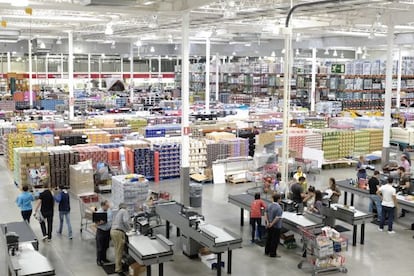US wholesaler Costco opens first Spanish megastore in Seville
Warehouse club confident it can overcome reticence of local customers to pay membership fee


They have managed to get 15,000 people to pay for the privilege of shopping at their store, and they haven’t even opened their doors yet.
The US warehouse club chain Costco is disembarking in Spain with a first establishment due to open in Seville today.
Though modest, this incursion into Spanish territory has not gone unnoticed by the distribution sector, which will keep a close watch on the performance of its new rival.
Costco is one of the world’s largest retailers, with 650 warehouses in nine countries. The Seville experiment is its first step in a bid to expand into continental Europe (it already has 25 stores in Great Britain).
You can buy a hot dog for one euro or a diamond ring for €70,000”
The Seville warehouse has a surface area of 15,000 square meters and employs 235 people. If things go well, new locations will open in Madrid, Barcelona and Valencia.
Besides more competition, Costco also represents a business model that is new to Spain: the warehouse club, which requires customers to pay an annual fee, in exchange for the promise of lower prices. Under the system, customers buy low-priced products in bulk from a limited range, which Costco chooses based on the supplier’s willingness to offer lower wholesale rates.
A similar wholesale cash-and-carry chain, Makro, has been in Spain for years, but is only open to business customers.
Costco’s annual membership fee is in the range of €25 to €30.
In the US, the company’s gross profit margin is around 10 percent, while for Spanish megastores margins are closer to 20 percent.
Costco will only offer around 3,500 products, compared with the 8,000 or so on display at midsize supermarkets.
Costco’s annual membership fee is in the range of €25 to €30
“This has caused something of a stir among existing chains in Spain, because this sector is already experiencing fierce competition. For now it’s just a store, but if the Costco model succeeds and expands, we will have to fight against a very strong multinational to retain our share of the pie,” say industry sources.
The idea of opening stores in Spain was first considered 15 years ago, said financial director Richard Galanti in October of last year. Since then, the biggest challenge has been to explain the chain’s philosophy.
“People who already knew Costco did not hesitate to join,” explains marketing director Roberto Cabreras. “Our first member is an American who is married to a woman from Seville; when he saw the building he walked in to sign up without even asking about the conditions, or even when we planned to open the store.”
“The shopping club spirit has yet to take hold in Spain; the first thing citizens ask us is why they should pay to shop. But everything changes when you explain the advantages,” he continues.
People who already knew Costco did not hesitate to join”
In recent weeks, 40 salespeople have been marketing the store door-to-door. “Word of mouth will do the rest,” says Cabreras.
The warehouse is located in Higuerón Sur industrial park, a 15-minute drive north from the city center.
“We chose Seville because the city has grown a lot in the last few years. It is simply chance that it is the site of our first location; negotiations went faster here than in Barcelona or Madrid,” explains Diane Tucci, the director general for Spain.
Tucci also said that expectations for the store are high, but that forecasts are “a secret.” She hopes that the workforce will grow from 235 to 250, joining Costco’s 178,000 employees globally. Last year, sales were €102.9 billion.
Costco Seville will carry all types of products. “You can buy a hot dog for one euro or a diamond ring for €70,000,” explains Roberto Cabreras.
The shelves already stock boxes of kitchen appliances, beauty products, food and more.
“We are very strong on fresh produce: meat, baked goods...” says Tucci.
“I am especially interested in food,” confirms Antonio Luna, a retired man. “If all the food has lower prices, I will no longer have to search several stores looking for special offers,” said Sonia de la Torre, a 37-year-old housewife.
Of the members so far, 35 percent are businesses. “Normally, this sector represents 40 percent of membership compared with 60 percent of the general public. We are convinced that after we open, more businesspeople will join the club. All they have to do is see the prices,” says Tucci.
Tu suscripción se está usando en otro dispositivo
¿Quieres añadir otro usuario a tu suscripción?
Si continúas leyendo en este dispositivo, no se podrá leer en el otro.
FlechaTu suscripción se está usando en otro dispositivo y solo puedes acceder a EL PAÍS desde un dispositivo a la vez.
Si quieres compartir tu cuenta, cambia tu suscripción a la modalidad Premium, así podrás añadir otro usuario. Cada uno accederá con su propia cuenta de email, lo que os permitirá personalizar vuestra experiencia en EL PAÍS.
¿Tienes una suscripción de empresa? Accede aquí para contratar más cuentas.
En el caso de no saber quién está usando tu cuenta, te recomendamos cambiar tu contraseña aquí.
Si decides continuar compartiendo tu cuenta, este mensaje se mostrará en tu dispositivo y en el de la otra persona que está usando tu cuenta de forma indefinida, afectando a tu experiencia de lectura. Puedes consultar aquí los términos y condiciones de la suscripción digital.
Últimas noticias
The complicated life of Francesca Albanese: A rising figure in Italy but barred from every bank by Trump’s sanctions
Half of Scotland is in the hands of 420 property owners
Reinhard Genzel, Nobel laureate in physics: ‘One-minute videos will never give you the truth’
Pinochet’s victims grapple with José Antonio Kast’s rise in Chile
Most viewed
- Pablo Escobar’s hippos: A serious environmental problem, 40 years on
- Why we lost the habit of sleeping in two segments and how that changed our sense of time
- Charles Dubouloz, mountaineering star, retires at 36 with a farewell tour inspired by Walter Bonatti
- Reinhard Genzel, Nobel laureate in physics: ‘One-minute videos will never give you the truth’
- The Florida Keys tourist paradise is besieged by immigration agents: ‘We’ve never seen anything like this’








































